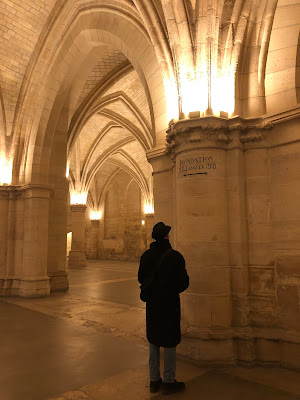La Conciergerie


Inspecting the high-water mark of the 1910 Paris Flood, La Conciergerie, 1st Arr.
 |
| The ledger of La Conciergerie's temporary guests. Like Santa's naughty list, but more arbitrary and with beheading instead of a lump of coal. |
I guess I expected depictions of the squalor and misery that prisoners experienced as they awaited to be summoned for their near-certain death. Admittedly, my sources on conditions inside were from fictional accounts such as Jean Renoir's 1938 film La Marseillaise, and from Edward Carey's Little, a novel based on the early life of Marie Grosholtz, a sculptor whose wax casts of nobles such as the Duc D'Orleans, the Comtesse du Barry, and Louis XVI aroused suspicions of royal sympathies. Grosholtz survived La Conciergerie and reinvented herself in London as Madame Tussaud--whose fictionalized story I read after a recent visit to Musée Grevin. The exhibits certainly described the horrid conditions in ways that made the fictional depictions seem pretty accurate--cramped, damp, infested with rats and lice, with very little food (and that only barely edible) and only dirty straw as bedding. But none of that was actually recreated in displays. In fact, the parts of La Conciergerie that served as a historical museum were uniformly clean and pristine, without any furnishings or objects from its medieval origins or Revolutionary ignominy, save for three recreations of offices and some items belonging to Marie Antoinette.
 |
| The welcoming façade of La Conciergerie from the Pont au Change, 1st Arr. |
The surprising thing about La Conciergerie was that it provided one of the most concise, readable histories of the French Revolution that I've encountered. What I can say that I "know" about the Revolution I've picked up in dribs and drabs from different sources; museum visits, films, articles, Mad magazine. The history books I've tried to read on the subject have been, without exception, dense, poorly-written, and dull. They all shared the bad habit of interrupting the narrative with long, bloviating diversions into who gave what speech at what meeting of the revolutionary council on what date. I'm sure those details are important to historians, but they do not give the lay reader much of a sense of why the Revolution occurred when it did, why it took its particularly bloody, totalitarian course, and how it ended. To this date, I can't recall the essential differences between a Jacobin, a Girondin, or a Sans Culottes. I'm still fuzzy on how the Marquis de Lafayette kept his head when it should have came off at several critical junctures. Maybe this is just a quirk of writing about rapid, sweeping, political and social change. John Reed's 10 Days That Shook the World, a first person journalistic account of the Bolshevik Revolution in Russia and the basis for the (unwatchable) movie Reds, suffers the same problem.
But La Conciergerie told the story through the lens of a single aspect of the Revolution, the administration of justice. Narrowing the focus in this way allows the visitor to place the big picture events--the storming of the Bastille, the beheading of the monarchs, the war with Austria, the ascension of Napoleon Bonaparte--into a narrative context without flying off in a thousand directions trying to accommodate every personality and event that entered and existed the historical stage. It didn't answer all my questions, but at least gave me a better sense of which social and historical elements mattered to turn an initially democratic movement into a tyrannical bloodbath that is still shocking today. That's enough to ask of any museum, and gives me a method for selecting my next book on the topic: single subjects only, please.
 |
| For next month's book club, we'll be reading "Just Shut Up and Kill," by Maximilien Robespierre. |



Comments
Post a Comment